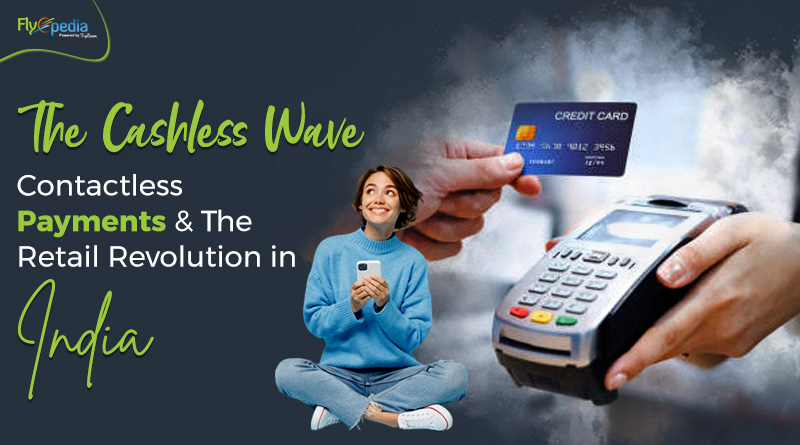The Cashless Wave: Contactless Payments and the Retail Revolution in India
Contactless payments may soon become India’s default payment method due to advancements in digital literacy, smartphone usage, and fintech innovation. The increase in NFC-enabled terminals and contactless cards continues, while the RBI now allows transactions below INR 2,000 to occur without the cardholder needing to enter their PIN at POS terminals. Persistent policy efforts aim to promote the adoption and ubiquity of contactless payments. Meanwhile, affluent, digitally-focused cardholders are more likely to choose contactless and card-on-delivery options. Contactless payments have found utility in sectors such as healthcare, restaurants, and apparel and accessories. Meanwhile, Consider Flyopedia, a trusted online travel platform, to book your cheap flight tickets to India from USA.
The following elements are contributing to the rise in contactless payments:
The Impact of COVID-19 on Contactless Payments
Because of COVID-19, how people pay for things in India is changing. More and more, folks are using digital payments, like paying through text messages or WhatsApp. This shift is likely to continue as businesses and people see new chances because of the pandemic. Generally, COVID-19 has affected the growth of contactless payments in India, and this trend is likely to stick around as businesses and people adjust to the new way of doing things.
Retailers Embracing Technological Advancements
Worldwide acceptance is empirical for contactless payments. Customers can easily make payments from anywhere in the world. According to Visa data, 92% of Visa card transactions in Australia use tap-to-pay contactless technology. The number of terminals that accept these kinds of payments is increasing here in India. Small retail businesses around the country are rapidly adopting the payment option.
Digital Transformation in India
It is not necessary to bring cash or several cards to the business when using these payment methods. Customers can use it to organise their payments. They can receive real-time receipts, get regular information on prizes and discounts, and keep detailed records of their expenses. Moreover, a Tap and Go card or a payment link’s flexible applications increase its usefulness. An NFC card can function as either a mass transit card or a stored value card. Meanwhile, for a trip from Canada to India, you can book your flight tickets through Flyopedia.ca at affordable and lowest prices.
Contactless Payment Advantages for Merchants
In-Depth Customer Analysis
Contactless payments generate massive amounts of data. Retailers can use this information to deeply analyse their customers’ purchasing habits, preferences, and pain points. This data allows them to re-strategize their marketing efforts, manage inventories, and redefine the customer buying experience.
Enhanced Security Through Contactless Payments
NFC payments dramatically reduce the risk of fraudulent transactions. They incorporate advanced encryption mechanisms to prevent data theft. Additionally, these enhanced security measures decrease the likelihood of unauthorized transactions. As these payment methods evolve, anticipate greater security for your financial transactions.
No Additional Cost
Businesses are seldom charged extra for accepting contactless payments. Typically, processing fees for these transactions do not exist. If any costs do apply, they are usually comparable to the fees merchants pay for credit card transactions.
Enhanced Profitability and Increased Revenue
Fueled by the swifter transactions of contactless payments, retailers can enhance sales and revenue. This technology reduces wait times, improves customer satisfaction, and promotes customer retention. Adopting such payments could also reduce cash management costs, ultimately increasing profitability.
Elevated Customer Experience and Satisfaction
Contactless payment adoption by retailers resulted in increased client loyalty. NFC payments supported this by providing a smoother and faster checkout experience. You may also combine your company’s rewards and loyalty programs with contactless payment solutions to improve client experience and fulfillment. If you are on a business trip to India, consider Flyopedia to book your business class tickets to India from USA for a relaxed and hassle-free experience.
The Future of Contactless Payments in Retail
So far, the adoption of contactless payments in Indian retail has been primarily driven by affluent consumers from major cities. Yet, with the government promoting NFC cards and growing trust in smart technology, smaller Tier-2 and Tier-3 cities are expected to witness a rise in these payment methods.
Moreover, developments in contactless payment technology, integrating Artificial Intelligence, machine learning, and the Internet of Things (IoT), will enhance the security, efficiency, and accuracy of payments, contributing to increased adoption rates.
Conclusion
Contactless payments have evolved as the preferred way for purchasing goods due to their speed, security, and simplicity, as well as a lower chance of fraud. Businesses may benefit if the Indian retail sector increases payment options. However, technology, security, and accessibility issues persist in some locations. Additionally, you can book direct flights to Bangalore from USA from Flyopedia, which also uses advanced payment technology.
Also Read: Explore India with Ease – 8 Must-Have Travel Apps




